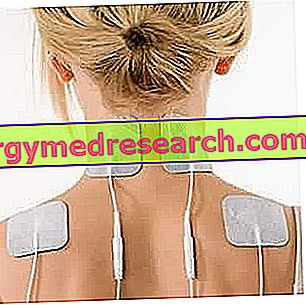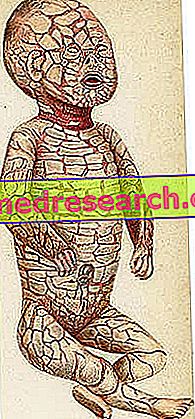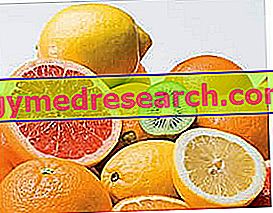Premise
The following indications are for information purposes EXCLUSIVELY and are not intended to replace the opinion of professional figures such as doctor, nutritionist or dietician, whose intervention is necessary for the prescription and composition of CUSTOMIZED food therapies.

High protein diet
The high-protein diet is a diet that is based on the extraordinary increase of proteins at the expense of the fraction of carbohydrates and, to a lesser extent, of fats.
The term "hyperproteic" is generic, since - considering what mentioned by the LARN (Nutrient Recommended Intake Levels for the Italian population - SINU) - for the adult subject, protein coefficients higher than 0.75-0.8 g / kg of weight they are already EXCESSIVE and SUFFICIENT to define a HYPERPROTEIC diet; this does not mean that, for reasons of various kinds (such as intense sport or chronic malabsorption), it is possible to increase the coefficient of protein in the diet up to twice the basic recommendations (but not beyond!) without incurring the risk of exceeding the urinary excretion of calcium, as the first drawback of common high-protein diets (Committee for Nutrition and Health of the Nutrition Board of the NRC USA - NRC, 1989). On the other hand, protein levels of 98g / day (> of the Italian average) are already correlated to increased urinary excretion of calcium (Saba et al., 1990).
To be honest, it is definitely rare that a diet (albeit calibrated) uses protein values of 0.75g / kg because, being macronutrients almost "ubiquitous" in food, their contribution also derives from the sum of low and medium value peptides organic (legumes, cereals, vegetables, mushrooms and fruit). In my opinion, a coefficient of 1.2g / kg of PHYSIOLOGICAL weight (always correct on the basis of the muscular entity) is a good compromise between "recommendations" and "practicability of the diet".
Logically, the term hyperprotein "should" be associated with a diet that provides more than 1.5g / kg of desirable physiological weight in the adult, including the risk of urinary excretion of blood and bone calcium. We also remember that high-protein diets:
- Increase liver deamination and transamination processes
- Increase urea cycle processes
- Increase kidney filtration processes
therefore, they are potentially responsible for long-term hepato-renal overload; nevertheless, since this is a difficulty that is difficult to find in the young adult, this aspect is often underestimated and considered as a form of "nutritional delirium" belonging to the old nutritional school.
NB : Always for ethical correctness, we recall that in addition to the high-protein, even excessively low-calorie and unbalanced diets, the intense and prolonged sport NOT adequately supported with nutrition and fasting have the same effects as the high-protein diet due to the hyperactivation of neoglucogenesis, depleting significantly skeletal muscle tissue.
The high-protein diet is also a potentially acidic diet, which favors the lowering of blood pH and requires the intervention of organic buffer systems, therefore, a useful dietary measure would be to ensure good doses of magnesium and other alkalizing mineral salts.
Except for the peptide quota estimate, there are no other essential considerations regarding the composition of the high-protein diet; let us remember only that it can be used both for weight loss and, in association with the increase in carbohydrates and fats, for the increase in body mass.
NB . The high-protein diet, even if low in carbohydrates, is to be considered potentially ketogenic; this feature further worsens the tendency to metabolic acidosis and furthermore promotes body dehydration with the loss of numerous electrolytes.
Useful supplements in the case of a high-protein diet
The high protein diet, if properly managed, does not require any food supplement; however, in cases where the organization of meals is particularly problematic, they may be useful:
- Protein supplements: protein powder (whey, casein, soy, egg), gainer and protein bars; with these products the daily protein intake is facilitated with the advantage of preservability and transportability.
- Supplements of branched or essential amino acids: if well contextualized, they can favor the achievement of plastic needs at lower doses, thus limiting liver and kidney overload. The branched ones have a good anti-catabolic function, especially in association with maltodextrins to be taken before, during and immediately after training.
- Purifying liver teas, as long as they are not excessively draining: some herbal teas can promote the purification of suffering liver cells; a classic example is the herbal tea based on: cumin, turmeric, milk thistle, dandelion and mint . It would therefore be advisable to associate such products with high-protein diets, making sure that, in the case of ketosis, this does not promote dehydration and worsens the electrolyte imbalance.
Example
- Elderly sedentary gentleman, slightly overweight, who has undergone a partial bowel resection operation and has clear symptoms of malnutrition, probably due to post-operative malabsorption.
| Sex | Male | |||
| Age | 73 | |||
| Stature cm | 175 | |||
| Wrist circumference cm | 18.2 | |||
| Constitution | Robust | |||
| Stature / wrist | 9.6 | |||
| Morphological type | normolineo | |||
| Weight kg | 80 | |||
| Body mass index | 26.1 | |||
| Desirable physiological body mass index | 24.1 | |||
| Desirable physiological weight kg | 73.8 | |||
| Basal kcal metabolism | 1578.2 | |||
| Coefficient of physical activity level | Lightweight, No Aus. 1.40 | |||
| Kcal energy expenditure | 2210 | |||
| Diet | NORMO CALORICA * | 2110 Kcal * | ||
| Lipids | 25% | 552, 5Kcal | 61.4 g | |
| Protein | 2g / kg | 590, 4Kcal | 147, 6g | |
| Carbohydrates | 48.3% | 1067, 1kcal | 284, 6g | |
| Alcohol | 0g | |||
| Breakfast | 15% | 332kcal | ||
| Snack | 5% | 110kcal | ||
| Lunch | 40% | 884kcal | ||
| Snack | 5% | 110kcal | ||
| Dinner | 35% | 773kcal | ||
* We chose not to administer an IPO-caloric despite being overweight for 2 reasons:
- The presence of malnutrition, which must first be compensated
- The need for the elderly to preserve a modest fat layer as it is conservative towards injuries of a traumatic nature.
WARNING! By virtue of the foregoing on the effects of the high-protein diet on urinary calcium excretion, it is necessary to specify that, in this specific example, the protein fraction (despite being> 98g / day) should compensate for the intestinal absorption limitations and, therefore, it would not be excessive; however, considering the subject's age and the relative tendency to bone loss, it is advisable to continue the diet in question ONLY until the state of nutrition is recovered and subsequently to supplement the maintenance diet (characterized by a protein intake not exceeding 1.5g / kg) with essential amino acids in doses of less than or equal to 1g per 10kg of desirable physiological weight.
Example of a High Protein Diet - Day 1
| Breakfast 15% kcal TOT | |||
| Milk with reduced fat content, delactosate | 300ml, 150kal | ||
| Sweetened coffee | 35ml, 20kcal | ||
| Stale wheat bread | 60g, 159.6kcal | ||
| Snack 5% kcal TOT | |||
| Wheat bread | 30g, 79.8kcal | ||
| Sliced turkey breast | 30g, 33.3kcal | ||
| Lunch 40% kcal TOT | |||
| Pasta with tomato sauce | |||
| Semolina pasta | 90g, 320.4kcal | ||
| Tomato puree | 100g, 24kcal | ||
| Parmigiano | 10g, 39.2kcal | ||
| Low fat flakes, 2% | 150g, 129kcal | ||
| Lettuce | 100g, 28kcal | ||
| Wheat bread | 30g, 79.8kcal | ||
| Extra virgin olive oil | 15g, 135kcal | ||
| Apple | 200g, 104kcal | ||
| Snack 5% kcal TOT | |||
| Pere | 200g, 116kcal | ||
| Dinner 35% kcal TOT | |||
| Pork chop | |||
| Lean pork chop | 300g, 381kcal | ||
| Biete or chard | 200g, 38kcal | ||
| Extra virgin olive oil | 15g, 135kcal | ||
| Wheat bread | 90g, 239.4kcal | ||
Example of a High Protein Diet - Day 2
| Breakfast 15% kcal TOT | |||
| Milk with reduced fat content, delactosate | 300ml, 150kal | ||
| Sweetened coffee | 35ml, 20kcal | ||
| Stale wheat bread | 60g, 159.6kcal | ||
| Snack 5% kcal TOT | |||
| Wheat bread | 30g, 79.8kcal | ||
| Baked ham | 15g, 32.3kcal | ||
| Lunch 40% kcal TOT | |||
| Mushroom risotto | |||
| Polished rice | 90g, 336.6kcal | ||
| Field mushrooms | 100g, 22kcal | ||
| Parmigiano | 10g, 39.2kcal | ||
| Grilled chicken breast | 150g, 165kcal | ||
| Red radish | 100g, 23kcal | ||
| Wheat bread | 30g, 79.8kcal | ||
| Extra virgin olive oil | 15g, 135kcal | ||
| Kiwi | 150g, 91.5kcal | ||
| Snack 5% kcal TOT | |||
| oranges | 150g, 94.5kcal | ||
| Dinner 35% kcal TOT | |||
| Baked sea bass | |||
| Sea bass, various species | 300g, 291kcal | ||
| Fennel | 200g, 22kcal | ||
| Extra virgin olive oil | 20g, 180kcal | ||
| Wheat bread | 90g, 239.4kcal | ||
Example of a High Protein Diet - Day 3
| Breakfast 15% kcal TOT | |||
| Milk with reduced fat content, delactosate | 300ml, 150kal | ||
| Sweetened coffee | 35ml, 20kcal | ||
| Stale wheat bread | 60g, 159.6kcal | ||
| Snack 5% kcal TOT | |||
| Wheat bread | 30g, 79.8kcal | ||
| Raw, lean ham | 15g, 32.7kcal | ||
| Lunch 40% kcal TOT | |||
| Stewed beans | |||
| Ripe beans | 300g, 351kcal | ||
| Parmigiano | 10g, 39.2kcal | ||
| Natural tuna, drained | 120g, 153.6kcal | ||
| Rocket salad | 100g, 25kcal | ||
| Wheat bread | 30g, 79.8kcal | ||
| Extra virgin olive oil | 15g, 135kcal | ||
| Clementine | 200g, 94kcal | ||
| Snack 5% kcal TOT | |||
| European grapes | 200g, 138kcal | ||
| Dinner 35% kcal TOT | |||
| Grilled sirloin | |||
| Veal sirloin | 300g, 330kcal | ||
| spinach | 200g, 46kcal | ||
| Extra virgin olive oil | 15g, 135kcal | ||
| Wheat bread | 90g, 239.4kcal | ||
Example of a High Protein Diet - Day 4
| Breakfast 15% kcal TOT | |||
| Milk with reduced fat content, delactosate | 300ml, 150kal | ||
| Sweetened coffee | 35ml, 20kcal | ||
| Stale wheat bread | 60g, 159.6kcal | ||
| Snack 5% kcal TOT | |||
| Wheat bread | 30g, 79.8kcal | ||
| Sliced turkey breast | 30g, 33.3kcal | ||
| Lunch 40% kcal TOT | |||
| Pasta with zucchini | |||
| Semolina pasta | 90g, 320.4kcal | ||
| Zucchini | 100g, 16kcal | ||
| Parmigiano | 10g, 39.2kcal | ||
| Low fat flakes, 2% | 150g, 129kcal | ||
| Lettuce | 100g, 28kcal | ||
| Wheat bread | 30g, 79.8kcal | ||
| Extra virgin olive oil | 15g, 135kcal | ||
| Apple | 200g, 104kcal | ||
| Snack 5% kcal TOT | |||
| Pere | 200g, 116kcal | ||
| Dinner 35% kcal TOT | |||
| Ricotta cheese | |||
| Cow ricotta, from semi-skimmed milk | 300g, 414kcal | ||
| carrots | 200g, 82kcal | ||
| Extra virgin olive oil | 10g, 90kcal | ||
| Wheat bread | 90g, 239.4kcal | ||
Example of a High Protein Diet - Day 5
| Breakfast 15% kcal TOT | |||
| Milk with reduced fat content, delactosate | 300ml, 150kal | ||
| Sweetened coffee | 35ml, 20kcal | ||
| Stale wheat bread | 60g, 159.6kcal | ||
| Snack 5% kcal TOT | |||
| Wheat bread | 30g, 79.8kcal | ||
| Baked ham | 15g, 32.3kcal | ||
| Lunch 40% kcal TOT | |||
| Pumpkin and gorgonzola risotto | |||
| Polished rice | 90g, 336.6kcal | ||
| Pumpkin | 100g, 26kcal | ||
| Gorgonzola | 30g, 105.9kcal | ||
| Parmigiano | 10g, 39.2kcal | ||
| Grilled chicken breast | 150g, 165kcal | ||
| Red radish | 100g, 23kcal | ||
| Wheat bread | 30g, 79.8kcal | ||
| Extra virgin olive oil | 15g, 135kcal | ||
| Kiwi | 150g, 91.5kcal | ||
| Snack 5% kcal TOT | |||
| oranges | 150g, 94.5kcal | ||
| Dinner 35% kcal TOT | |||
| Ox eye eggs | |||
| Whole medium chicken eggs, 60g with shell | 100g, 143kcal | ||
| Boiled potatoes | 200g, 154kcal | ||
| Extra virgin olive oil | 15g, 180kcal | ||
| Wheat bread | 90g, 239.4kcal | ||
Example of a High Protein Diet - Day 6
| Breakfast 15% kcal TOT | |||
| Milk with reduced fat content, delactosate | 300ml, 150kal | ||
| Sweetened coffee | 35ml, 20kcal | ||
| Stale wheat bread | 60g, 159.6kcal | ||
| Snack 5% kcal TOT | |||
| Wheat bread | 30g, 79.8kcal | ||
| Raw, lean ham | 15g, 32.7kcal | ||
| Lunch 40% kcal TOT | |||
| Stewed lentils | |||
| Dried lentils | 100g, 353kcal | ||
| Parmigiano | 10g, 39.2kcal | ||
| natural tuna, drained | 120g, 153.6kcal | ||
| Rocket salad | 100g, 25kcal | ||
| Wheat bread | 30g, 79.8kcal | ||
| Extra virgin olive oil | 15g, 135kcal | ||
| Clementine | 200g, 94kcal | ||
| Snack 5% kcal TOT | |||
| European grapes | 200g, 138kcal | ||
| Dinner 35% kcal TOT | |||
| Horse Steak | |||
| Horse Steak | 250g, 332.5kcal | ||
| Eggplant | 200g, 48kcal | ||
| Extra virgin olive oil | 15g, 135kcal | ||
| Wheat bread | 90g, 239.4kcal | ||
Example of a High Protein Diet - Day 7
| Breakfast 15% kcal TOT | |||
| Milk with reduced fat content, delactosate | 300ml, 150kal | ||
| Sweetened coffee | 35ml, 20kcal | ||
| Stale wheat bread | 60g, 159.6kcal | ||
| Snack 5% kcal TOT | |||
| Wheat bread | 30g, 79.8kcal | ||
| Sliced turkey breast | 30g, 33.3kcal | ||
| Lunch 40% kcal TOT | |||
| Pasta with meat sauce | |||
| Semolina pasta | 90g, 320.4kcal | ||
| Ragù with tomato | 100g, 150kcal | ||
| Parmigiano | 10g, 39.2kcal | ||
| Lettuce | 100g, 28kcal | ||
| Wheat bread | 30g, 79.8kcal | ||
| Extra virgin olive oil | 15g, 135kcal | ||
| Apple | 200g, 104kcal | ||
| Snack 5% kcal TOT | |||
| Pere | 200g, 116kcal | ||
| Dinner 35% kcal TOT | |||
| Sea bream in foil | |||
| Sea bream | 300g, 363kcal | ||
| Biete or chard | 200g, 38kcal | ||
| Extra virgin olive oil | 15g, 135kcal | ||
| Wheat bread | 90g, 239.4kcal | ||



